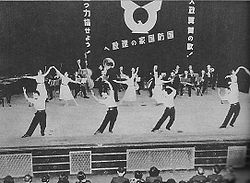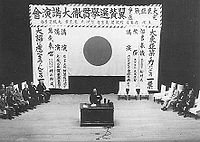- Taisei Yokusankai
-
Imperial Rule Assistance Association
大政翼賛会
Taisei Yokusankai
Leader Fumimaro Konoe
(12 October 1940-18 October 1941)
Hideki Tōjō
(18 October 1941–22 July 1944)
Kantarō Suzuki
(7 April 1945-13 June 1945)Founded October 12, 1940 Dissolved June 13, 1945 Preceded by Imperial Way Faction, Tōhōkai Succeeded by None; banned Headquarters Tokyo, Japan Youth wing Yokusan Sonendan Paramilitary wing Yokusan Sonendan Ideology Para-fascism
National syndicalism
Japanese nationalism
Shōwa period Statism
Japanese militarism
State ShintoPolitical position Far right International affiliation N/A Official colors White, Red (Colours of the Flag of Japan) The Taisei Yokusankai (大政翼賛会, "Imperial Rule Assistance Association" or "Imperial Aid Association") was Japan's para-fascist organization created by Prime Minister Fumimaro Konoe on October 12, 1940 to promote the goals of his Shintaisei ("New Order") movement. It evolved into a "statist" ruling political party which aimed at removing the sectionalism in the politics and economics in the Empire of Japan to create a totalitarian single-party state, in order to maximize efficiency of Japan’s total war effort in China.[1] When the organization was launched officially, Konoe was hailed as a "political savior" of a nation in chaos; however, internal divisions soon appeared.
Contents
Origins
Based on recommendations by the Shōwa Kenkyūkai, Konoe originally conceived of the Imperial Rule Assistance Association as a reformist political party to overcome the deep-rooted differences and political cliques between bureaucrats, politicians and the military. During the summer of 1937, Konoe appointed 37 members chosen from a broad political spectrum to a preparatory committee which met in Karuizawa, Nagano. The committee included Konoe's political colleagues Fumio Gotō, Count Yoriyasu Arima and ex-syndicalist and right wing spokesman Fusanosuke Kuhara. The socialist and populist left wing was represented by Kingoro Hashimoto and the traditionalist military wings by Senjūrō Hayashi, Heisuke Yanagawa and Nobuyuki Abe.
Konoe proposed originally that the Imperial Rule Assistance Association be organized along nationalist syndicalism lines, with new members assigned to branches based on occupation, which would then develop channels for mass participation of the common population to “assist with the Imperial Rule”.[2]
However, from the start, there was no consensus in a common cause, as the leadership council represented all ends of the political spectrum, and in the end, the party was organized along geographic lines, following the existing political sub-divisions. Therefore, all local government leaders at each level of village, town, city and prefectural government automatically received the equivalent position within their local Imperial Rule Assistance Association branch.[3]
Ideals
Prior to creation of the Imperial Rule Assistance Association, Konoe had already passed the National Mobilization Law, which effectively nationalized strategic industries, the news media, and labor unions, in preparation for total war with China.
Labor unions were replaced by the Nation Service Draft Ordinance, which empowered the government to draft civilian workers into critical war industries. Society was mobilized and indoctrinated through the National Spiritual Mobilization Movement, which organized patriotic events and mass rallies, and promoted slogans such as "Yamato-damashii" and "Hakkō ichiu" to support Japanese militarism. This was urged to "restore the spirit and virtues of old Japan".[4]
Some objections to it came on the grounds that kokutai, imperial polity, already required all imperial subjects to support imperial rule.[5]
In addition to drumming up support for the ongoing wars in China and in the Pacific, the Imperial Rule Assistance Association helped maintain public order and provided certain public services via the tonarigumi neighborhood association program.[6] It also played a role in increasing productivity, monitoring rationing, and organizing civil defense.
The Imperial Rule Assistance Association was also militarized, with its members donning khaki-colored uniforms. In the last period of the conflict, the membership received military training and was projected to integrate with civil militia in case of the anticipated American invasion.
Development
As soon as October 1940, the Imperial Rule Assistance Association systemized and formalized the Tonarigumi, a nationwide system of neighborhood associations. The November 6, 1940 issue of Shashin Shūhō (Photographic Weekly Report) explained the purpose of this infrastructure:
The Taisei Yokusankai movement has already turned on the switch for rebuilding a new Japan and completing a new Great East Asian order which, writ large, is the construction of a new world order. The Taisei Yokusankai is, broadly speaking, the New Order movement which will, in a word, place One Hundred Million into one body under this new organisation that will conduct all of our energies and abilities for the sake of the nation. Aren't we all mentally prepared to be members of this new organization and, as one adult to another, without holding our superiors in awe or being preoccupied with the past, cast aside all private concerns in order to perform public service ? Under the Taisei Yokusankai are regional town, village, and tonarigumi, let's convene council meetings and advance the activities of this organization.[7]
In February 1942, all women’s associations were merged into the Greater Japan Women's Association which joined the Imperial Rule Assistance Association in May. Every adult woman in Japan, excepting the under twenty and unmarried, was forced to join the Association.[8]
Likewise, in June, all youth organizations were merged into the Greater Japan Imperial Rule Assistance Youth Corps (翼賛青年団), based on the model of the German Sturmabteilung (stormtroopers).[9]
In March 1942, Prime Minister Hideki Tōjō attempted to eliminate the influence of elected politicians by establishing an officially-sponsored election nomination commission, which restricted non-government sanctioned candidates from the ballot.[10] After the 1942 Japanese General Election, all members of Diet were required to join the Yokusan Seijikai (Imperial Rule Assistance Political Association), which effectively made Japan a single-party state. However, as the old political leadership within the Diet retained their seats and influence, Japan never evolved completely into totalitarianism. The Imperial Rule Assistance Association was formally dissolved on June 13, 1945.
During the occupation of Japan, the American authorities purged thousands of government leaders from public life for having been members of the Association.
References
- Aldus, Christop (1999). The Police in Occupation Japan: Control, Corruption and Resistance to Reform. Routeledge. ISBN 0415145260.
- Duus, Peter (2001). The Cambridge History of Japan. Palgrave Macmillan. ISBN 0312239157.
- Sims, Richard (2001). Japanese Political History Since the Meiji Renovation 1868-2000. Palgrave Macmillan. ISBN 0312239157.
- Stockwin, JAA (1990). Governing Japan: Divided Politics in a Major Economy. Vintage. ISBN 0679728023.
- Wolferen, Karen J (1990). The Enigma of Japanese Power;People and Politics in a Stateless Nation. Vintage. ISBN 0679728023.
Notes
- ^ Wolferen, The Enigma of Japanese Power;People and Politics in a Stateless Nation, page 351
- ^ Sims, Japanese Political History Since the Meiji Renovation 1868-2000, page 220
- ^ Duus, The Cambridge History of Japan, page 146
- ^ Edwin P. Hoyt, Japan's War, p 189 ISBN 0-07-030612-5
- ^ James L. McClain, Japan: A Modern History p 454 ISBN 0-393-04156-5
- ^ Aldus, The Police in Occupation Japan: Control, Corruption and Resistance to Reform, page 36
- ^ David C. Earhart, Certain Victory, M.E. Sharpe, 2008, p.142, citing Shashin Shūhō
- ^ Modern Japan in archives, the Yokusan System, http://www.ndl.go.jp/modern/e/cha4/description15.html
- ^ Shillony, Ben-Ami (1981). Politics and Culture in Wartime Japan. Oxford University Press. pp. 23–33, 71–75. ISBN 0198202601. http://books.google.co.uk/books?id=PN1VOByJjE8C&pg=PA23&vq=young+men's+corps&dq=young+mens+corps+japan&as_brr=3&client=firefox-a&source=gbs_search_s&sig=uRB38jY0CBEbSE-TfcsPhEuo-QM#PPA23,M1.
- ^ Stockwin, Governing Japan: Divided Politics in a Major Economy, page 22
Fascism Theory Topics- Definitions
- Economics
- Fascism and ideology
- Fascism worldwide
- Symbolism
IdeasMovements AfricaAsia- Action Française
- Black Front (Netherlands)
- Breton Social-National Workers' Movement
- British Fascists
- British People's Party (1939)
- British Union of Fascists
- La Cagoule
- Clerical People's Party
- Faisceau
- Falange
- Flemish National Union
- French Popular Party
- General Dutch Fascist League
- Imperial Fascist League
- National Fascisti
- National Front (Switzerland)
- Nationalist Party (Iceland)
- National Socialist Dutch Workers Party
- National Socialist League
- National Socialist Movement in the Netherlands
- National Socialist Movement of Norway
- National Union (Portugal)
- New Party (UK)
- Rexism
- Arrow Cross Party
- Austrian National Socialism
- Fatherland's Front
- Hungarian National Socialist Party
- Italian Fascism
- Italian Social Republic
- Nasjonal Samling
- National Fascist Community
- National Fascist Party
- National Radical Camp Falanga
- National Socialist Bloc
- National Socialist Workers' Party (Sweden)
- Nazism
- Nazi Party
- Pērkonkrusts
- Republican Fascist Party
- Sammarinese Fascist Party
- Sudeten German Party
- Ustaše
- ZBOR
- Albanian Fascist Party
- Crusade of Romanianism
- Greek National Socialist Party
- Iron Guard* Lapua Movement
- National Fascist Movement
- National Italo-Romanian Cultural and Economic Movement
- National Social Movement (Bulgaria)
- National Romanian Fascia
- National Renaissance Front
- Patriotic People's Movement (Finland)
- Romanian Front
- Russian Fascist Party
- Russian Women's Fascist Movement
- Slovak People's Party
- Union of Bulgarian National Legions
North AmericaSouth AmericaPeople - Abba Ahimeir
- Sadao Araki
- Zoltán Böszörmény
- Corneliu Zelea Codreanu
- Gustavs Celmiņš
- Enrico Corradini
- Marcel Déat
- Léon Degrelle
- Giovanni Gentile
- Heinrich Himmler
- Fumimaro Konoe
- Adolf Hitler
- Ikki Kita
- Vihtori Kosola
- Dimitrije Ljotić
- Arnold Leese
- Oswald Mosley
- Benito Mussolini
- Eoin O'Duffy
- Gearóid Ó Cuinneagáin
- Ante Pavelić
- William Dudley Pelley
- Vidkun Quisling
- José Antonio Primo de Rivera
- Konstantin Rodzaevsky
- Plínio Salgado
- Ferenc Szálasi
- Anastasy Vonsyatsky
Works LiteraturePeriodicals- La Conquista del Estado
- Das Reich
- Der Angriff
- Deutsche Allgemeine Zeitung
- Deutsche Zeitung in Norwegen
- Deutsche Zeitung in den Niederlanden
- Figli d'Italia
- Fronten
- Gândirea
- Gioventù Fascista
- Je suis partout
- La France au travail
- Münchener Beobachter
- Novopress
- NS Månedshefte
- Norsk-Tysk Tidsskrift
- Das Schwarze Korps
- Der Stürmer
- Il Popolo d'Italia
- Sfarmă-Piatră
- Signal
- Vlajka* Völkischer Beobachter
- Nash Put'
FilmSculptureRelated topicsOrganizations InstitutionalActivist- Fascist Union of Youth
- German American Bund
- Russian Fascist Organization
- Union of Fascist Little Ones
- Union of Young Fascists – Vanguard (boys)
- Union of Young Fascists – Vanguard (girls)
ParamilitaryInternationalHistory 1910s1920s- Aventine Secession
- Acerbo Law
- March on Rome
- Beer Hall Putsch
- Italian economic battles
1930s1940sLists Related topics - Anti-fascism
- Anti-Nazi League
- Christofascism
- Clerical fascism
- Cryptofascism
- Ecofascism
- Esoteric Nazism
- Fascist (epithet)
- Germanisation
- Glossary of Nazi Germany
- Hitler salute
- Italianization
- Italianization of South Tyrol
- Islamofascism
- Japanization
- Ku Klux Klan
- Left-wing fascism
- Neo-fascism
- Neo-Nazism
- Roman salute
- Social fascism
- Synarchism
- Unite Against Fascism
- Völkisch movement
- Women in the Third Reich
Categories:- Politics of the Empire of Japan
- Japan in World War II
- Defunct political parties in Japan
- Banned far-right parties
- Political parties established in 1940
- Political parties disestablished in 1945
- Parties of single-party systems
Wikimedia Foundation. 2010.






